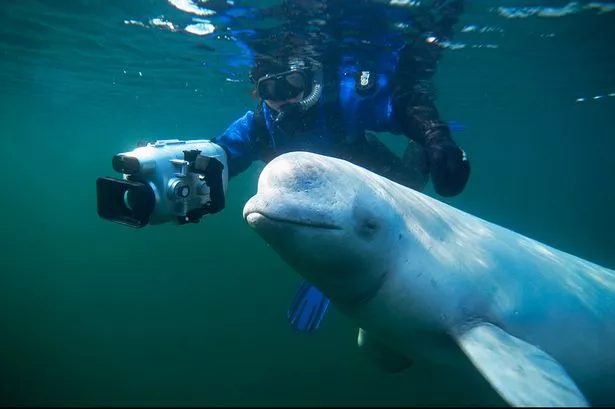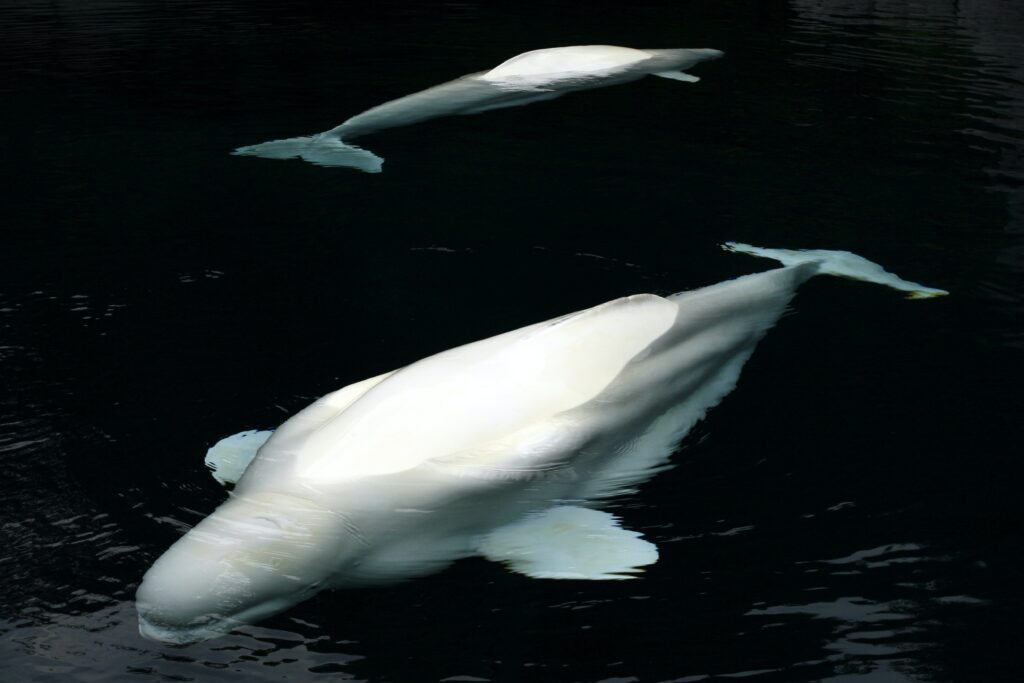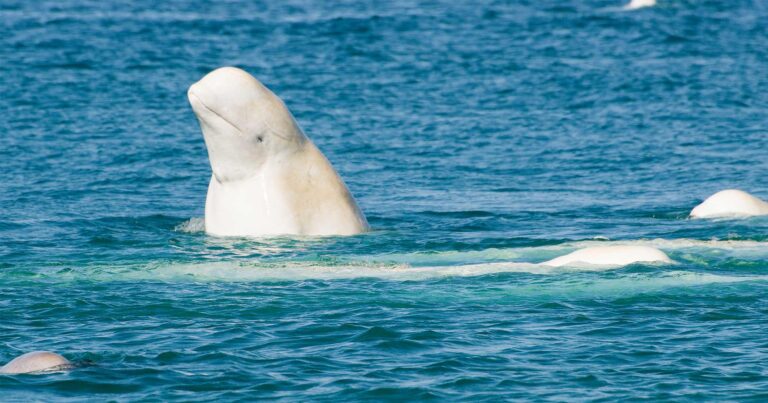In the vast and frigid waters of the Arctic and subarctic regions, a remarkable and enigmatic creature reigns supreme—the beluga whale, often referred to as the “canary of the sea” due to its distinctive vocalisations. These captivating marine mammals, known for their pristine white appearance and sociable nature, have long fascinated scientists, explorers, and nature enthusiasts alike. In this extensive article, we will delve deep into the world of beluga whales, exploring their biology, behaviour, habitat, and the ongoing conservation efforts aimed at preserving these iconic denizens of the northern oceans.
Beluga Whales: Arctic Guardians of the Sea

The Biology of Beluga Whales
Beluga whales (Delphinapterus leucas) are renowned for their striking physical features. Unlike their more famous relatives, such as the killer whale or humpback whale, belugas possess a unique appearance characterised by their brilliant white skin. This coloration, which sets them apart from other cetaceans, is due to a lack of pigmentation, as their skin is composed of a thick layer of blubber overlaid with a translucent epidermis. In essence, they are the Arctic’s ghostly inhabitants, perfectly adapted to their frozen surroundings.
These marine mammals are known for their robust bodies, measuring between 13 to 20 feet (4 to 6 meters) in length and weighing anywhere from 2,000 to 3,000 pounds (900 to 1,360 kilograms) on average. However, some individuals can reach even greater sizes. Among the toothed whales, belugas are unique for their lack of teeth in adulthood, instead sporting a set of conical pegs in their gum-like ridge.
Their physical adaptations extend beyond skin and teeth. Beluga whales possess a flexible neck, a feature that distinguishes them from other whales. This characteristic enables them to move their heads independently, making them highly agile in the water. Their melon-shaped heads, a prominent feature, houses a sophisticated echolocation system that assists in navigating through the dark and icy depths of their Arctic home.
Beluga Whales’ Sociable Nature
One of the most endearing qualities of beluga whales is their sociability. These highly gregarious creatures are often seen in groups, known as pods, which can range in size from just a few individuals to several dozen members. Within these pods, beluga whales engage in a variety of social behaviours, including vocalisations, play, and even cooperative hunting.
Beluga whales are renowned for their rich repertoire of sounds and vocalisations, earning them the title of “sea canaries.” They produce a wide range of clicks, whistles, and chirps, which they use to communicate with one another and navigate their surroundings. These vocalisations are not only a means of social interaction but also play a crucial role in their echolocation system, aiding in hunting and navigation.
In addition to their vocal talents, beluga whales are known for their playful nature. They can often be seen breaching, spy-hopping, and even engaging in synchronised swimming with fellow pod members. These playful behaviours are not only endearing to witness but also serve important social and cognitive functions within the pod.
Beluga Whales’ Diet and Feeding Habits
Beluga whales are opportunistic feeders, and their diet varies depending on their location and the availability of prey. While they primarily consume a diet of fish, their menu may also include crustaceans, squid, and other small marine creatures. Among their favoured prey species are Arctic cod and herring, which are abundant in the cold waters of the Arctic and subarctic regions.
Their unique feeding strategy involves hunting in various ways, such as using echolocation to locate prey and herding schools of fish into shallow waters where they can be more easily captured. Their flexible necks and lack of teeth in adulthood allow them to use suction to ingest their prey whole, making them highly efficient hunters.
Beluga Whale Habitat: A Life in the Icy Arctic
Beluga whales are masters of survival in some of the harshest environments on Earth—the Arctic and subarctic regions. These marine mammals are uniquely adapted to the extreme conditions of their habitat, where they navigate icy waters, endure frigid temperatures, and endure long periods of darkness during the harsh winter months.
One of the key adaptations of beluga whales is their ability to cope with extreme cold. Their thick blubber layer serves as insulation against the cold, allowing them to maintain their body temperature even in freezing waters. Additionally, their specialised blood circulation system helps distribute heat throughout their bodies, ensuring their extremities stay warm.
Beluga whales are highly migratory, following the changing seasons and the movements of their prey. During the summer months, when the Arctic ice retreats, they can be found in estuaries, coastal areas, and shallow bays where they give birth, socialise, and feed. However, as winter approaches and the ice begins to advance, they undertake long migrations to reach ice-covered areas, which offer them protection from predators like killer whales.
These migrations can span hundreds of miles, and they are a testament to the incredible navigational abilities of these whales. They rely on their keen sense of echolocation to navigate through the darkness and ice-covered waters with remarkable precision.
The Importance of Beluga Whale Conservation

While beluga whales are incredibly resilient, they face a host of challenges that threaten their survival. As apex predators in their ecosystem, they play a vital role in maintaining the health and balance of Arctic and subarctic marine ecosystems. However, they are vulnerable to a range of human-induced threats, including:
- Climate Change: The warming of Arctic waters and loss of sea ice have significant consequences for beluga whales. These changes can disrupt their migration patterns, alter their prey distribution, and expose them to new predators and diseases.
- Shipping Traffic: Increased shipping traffic in Arctic waters poses a risk of collisions with vessels, which can lead to injuries and fatalities among beluga whales. The noise from ships can also disrupt their echolocation and communication.
- Pollution: Pollution, including oil spills and contaminants like heavy metals, can have detrimental effects on beluga whales’ health and the health of their prey. These pollutants can accumulate in their blubber and impact their reproductive success.
- Overfishing: Overfishing of prey species, such as Arctic cod and herring, can reduce the availability of food for beluga whales, potentially leading to nutritional stress and population declines.
- Habitat Degradation: Coastal development and habitat destruction can disrupt beluga whales’ traditional calving and feeding areas, forcing them into less suitable habitats.
Given these challenges, conservation efforts are essential to protect beluga whales and their ecosystems. Several key strategies and initiatives are currently in place to safeguard these magnificent creatures:
1. Protected Areas: Establishing marine protected areas in beluga whale habitats can provide a safe haven for these animals, allowing them to feed, reproduce, and socialise without disturbance.
2. Monitoring and Research: Ongoing research and monitoring programs help scientists better understand beluga whale populations, their health, and their behaviours. This knowledge is critical for informed conservation decisions.
3. Regulation of Shipping: Implementing speed limits, rerouting shipping lanes, and educating mariners on the presence of beluga whales can help reduce the risk of ship strikes.
4. Pollution Control: Stricter regulations on industrial pollution, responsible waste disposal, and oil spill prevention measures can help reduce the impact of pollution on beluga whales and their habitats.
5. Climate Change Mitigation: Efforts to reduce greenhouse gas emissions and combat climate change are crucial for preserving the Arctic environment that beluga whales depend on.
Conclusion
Beluga whales are not just icons of the Arctic; they are vital components of the complex ecosystems they inhabit. Their unique adaptations, sociable nature, and remarkable behaviours make them treasures of the marine world. However, these magnificent creatures are facing numerous threats, from climate change to habitat degradation, that put their future at risk.
Conservation efforts are essential to ensure the continued existence of beluga whales and the health of the Arctic and subarctic ecosystems they call home. As guardians of the sea, it is our responsibility to protect and preserve these enigmatic creatures, ensuring that future generations can marvel at their beauty and grace in the icy waters of the North. Discover more Beluga conservation projects here.
UP NEXT
The Leafy Sea Dragon: Among the Strangest Ocean Creatures
Masters of Camouflage: The World of Cuttlefish



